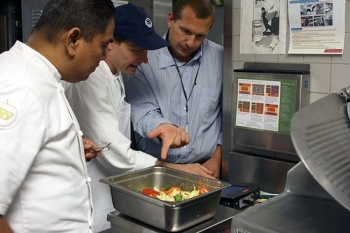Cal Dining: Food Waste Prevention

Results at a Glance
- Reduced food waste by 19%, equivalent to 27 tons per year.
- Cost of food waste avoided equivalent to saving more than $98,000 a year.
- Continue to reduce waste using automated food waste tracking system.
Overview
UC Berkeley’s foodservice provider Cal Dining measures types and amounts of pre-consumer food waste with specialized tracking equipment, then uses the findings to modify purchasing and food prep routines. As a result, Cal Dining has reduced food waste by 19%, equivalent to 27 tons/year, or $98,402/year in reduced food costs. Cal Dining is also benefitting from reducing trash by diverting food and other organics for composting. Going forward, Cal Dining expects to further reduce pre-consumer food waste by over 15 tons each year, saving close to $50,000 in additional avoided food purchases annually.
About Cal Dining
Cal Dining serves over 10,000 meals each day to UC Berkeley students and faculty at four residential dining halls on campus. Cal Dining is committed to quality and variety in their meal offerings, as well as sustainable practices in all aspects of their operations.
Challenge
Typical for a large-scale foodservice provider, Cal Dining generated significant amounts of pre-consumer food waste, including trim waste, expired and spoiled ingredients, leftovers from all you can eat dining halls. Although Cal Dining collects food waste for composting, the costs associated with these discards were significant—including expenses for food purchases, waste disposal and labor to handle the materials. In addition, Cal Dining wanted to minimize food waste in order to reduce its environmental impact, in line with the organization’s sustainability values.
Solution
With technical assistance from Lean Path and financial support from StopWaste, Cal Dining set up each dining hall with a LeanPath “ValuWaste” food waste tracking system—specialized equipment and software designed to weigh and record food waste in institutional kitchens. Placed where food waste is already being collected, the system consists of a digital scale and touch screen terminal. Every time a food waste item is discarded, its weight, type of food and reason for disposal are recorded. The system then calculates the cost of the item, based on pre-programmed values specific to Cal Dining and generates reports.
Each dining hall’s kitchen team was trained on using the equipment and formed a “SWAT Team,” usually led by the kitchen’s chef or sous chef. The teams have been meeting weekly to evaluate food waste reports and to discuss practical changes—such as altering menu items, quantities and preparation methods—to eliminate or generate less of specific food waste items.
Keys to Success
"In the first year of the project, we reduced food waste by over a third, saving us $1,600 each week in avoided food purchases alone."
- Chuck Davies, Director of Residential Dining, Cal Dining, UC Berkeley
- Tracking equipment is incorporated seamlessly into existing operations, without adding significant employee time to weigh and record food waste.
- Tracking equipment can be customized for specific settings and menus.
- Food waste reduction measures don’t affect quality or variety of menu items offered.
- SWAT team arrangement gives leaders sense of responsibility and keeps momentum going with regular meetings.
- Staff is motivated through onsite training, regular meetings and small rewards.